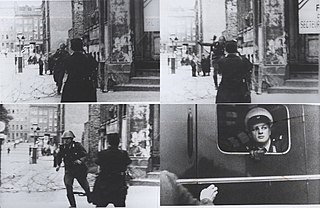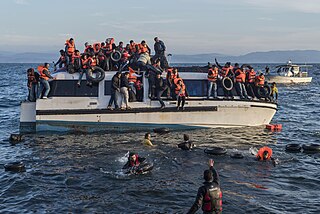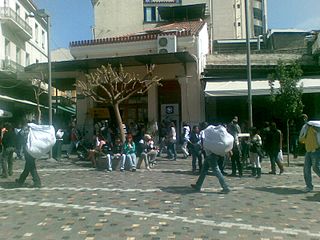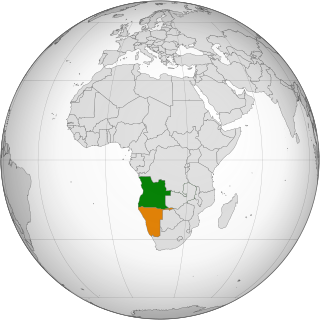Related Research Articles

The United Nations High Commissioner for Refugees (UNHCR) is a United Nations agency mandated to aid and protect refugees, forcibly displaced communities, and stateless people, and to assist in their voluntary repatriation, local integration or resettlement to a third country. It is headquartered in Geneva, Switzerland, with over 17,300 staff working in 135 countries.

The International Organization for Migration (IOM) is a United Nations agency that provides services and advice concerning migration to governments and migrants, including internally displaced persons, refugees, and migrant workers.

A refugee, generally speaking, is a displaced person who has crossed national borders and who cannot or is unwilling to return home due to well-founded fear of persecution. Such a person may be called an asylum seeker until granted refugee status by the contracting state or the United Nations High Commissioner for Refugees (UNHCR) if they formally make a claim for asylum. The lead international agency coordinating refugee protection is the United Nations Office of the UNHCR. The United Nations has a second office for refugees, the United Nations Relief and Works Agency (UNRWA), which is solely responsible for supporting the large majority of Palestinian refugees.
The history of Namibia has passed through several distinct stages from being colonised in the late nineteenth century to Namibia's independence on 21 March 1990.

A refugee camp is a temporary settlement built to receive refugees and people in refugee-like situations. Refugee camps usually accommodate displaced people who have fled their home country, but camps are also made for internally displaced people. Usually, refugees seek asylum after they have escaped war in their home countries, but some camps also house environmental and economic migrants. Camps with over a hundred thousand people are common, but as of 2012, the average-sized camp housed around 11,400. They are usually built and run by a government, the United Nations, international organizations, or non-governmental organization. Unofficial refugee camps, such as Idomeni in Greece or the Calais jungle in France, are where refugees are largely left without support of governments or international organizations.

Kavango was one of the thirteen regions of Namibia until it was split into the Kavango East and Kavango West Regions in 2013. Its capital was Rundu.

Forced displacement is an involuntary or coerced movement of a person or people away from their home or home region. The UNHCR defines 'forced displacement' as follows: displaced "as a result of persecution, conflict, generalized violence or human rights violations".

Rundu is the capital and largest city of the Kavango-East Region in northern Namibia. It lies on the border with Angola on the banks of the Kavango River about 1,000 metres above sea level. Rundu's population is growing rapidly. The 2001 census counted 36,964 inhabitants; and for the 2011 census it has climbed to 63,430.

Immigration to Greece percentage of foreign populations in Greece is 7.1% in proportion to the total population of the country. Moreover, between 9 and 11% of the registered Greek labor force of 4.4 million are foreigners. Migrants additionally make up 25% of wage and salary earners.
Bruno Geddo is an Italian national, born in Novara in 1959. He has served with the United Nations High Commissioner for Refugees (UNHCR) for over 30 years in Sub-Saharan Africa, North Africa and the Middle East.

Angolan–Namibian relations relate to the relations between the governments of the Republic of Angola and the Republic of Namibia.
Osire is a refugee camp in central Namibia, situated 200 km north of the capital Windhoek next to the main road C30 from Gobabis to Otjiwarongo. It was established in 1992 to accommodate refugees from Angola, Burundi, the Democratic Republic of the Congo, Rwanda and Somalia. The camp grew quickly in its early years, reaching a peak of 20,000 inhabitants in 1998. Since then the refugee population of Osire decreased steadily, approaching 6,500 in 2010, and 3,000 in 2014. Due to the cessation of conflicts in the countries where inhabitants originate from, the camp is scheduled to close. In 2008 the majority (75%) of refugees still resident here came from Angola, and a sizeable portion from the Democratic Republic of the Congo. UNHCR regards the camp as one of the best managed in the world, due to its provisioning of formal school education, both primary and secondary. The settlement further has a police station and a clinic.
African immigrants to Latin America include citizens and residents of countries in Latin America who were born in, or with recent ancestors from Africa. This excludes descendants of people who were forcibly transported to the Americas through the Atlantic slave trade.

Sudanese refugees in Israel refers to citizens of Sudan who have sought refuge in Israel due to military conflict at home, and to those who moved there illegally as migrant workers. In 2008, there were 4,000 Sudanese in Israel, 1,200 from Darfur and the remainder Christians from South Sudan. The majority entered through the Israeli-Egypt border. Most live in Tel Aviv, Arad, Eilat and Bnei Brak.
Africa Humanitarian Action is a non-governmental organization that provides relief services to countries in Africa. It was founded by Dr. David Zawde in 1994 in response to the Rwandan genocide.
The number of Chinese people in Namibia has grown tremendously since independence.

The 2015 European migrant crisis, also known internationally as the Syrian refugee crisis, was a period of significantly increased movement of refugees and migrants into Europe in 2015, when 1.3 million people came to the continent to request asylum, the most in a single year since World War II. Those requesting asylum in Europe in 2015 were mostly Syrians, but also included significant numbers of Afghans, Nigerians, Pakistanis, Iraqis and Eritreans, as well as economic migrants from the Balkans.
A refugee crisis can refer to difficulties and dangerous situations in the reception of large groups of forcibly displaced persons. These could be either internally displaced, refugees, asylum seekers or any other huge groups of migrants.
"Refugees as weapons", or "Weapon of Mass Migration" is a term used to describe a hostile government organizing, or threatening to organize, a sudden influx of refugees into another country with the intent of overwhelming its borders or causing political discomfort. It often exploits the targeted country's humanitarian obligations to take in refugees and hear their asylum claims. The responsible country usually seeks to extract concessions from the targeted country and achieve some political, military, and/or economic objective.
Migration and asylum policy of the European Union - is a policy within the area of freedom, security and justice, established to develop and harmonise principles and measures used by member countries of the European Union to regulate migration processes and to manage issues concerning asylum and refugee status in the European Union, in particular in the Schengen Area.
References
Notes
- ↑ Nangulah & Nickanor 2005, p. 4, 7
- 1 2 Nangulah & Nickanor 2005 , p. 1
- ↑ Brinkman 2009 , p. 275
- ↑ Brinkman 2009 , p. 285
- ↑ Nangulah & Nickanor 2005 , p. 4
- ↑ "Angolans Reported Escaping Into Namibia", The New York Times, 1989-06-12, retrieved 2009-09-12
- 1 2 3 UNHCR 2005 , p. 2
- ↑ Cauvin, Henry E. (1999-11-26), "A Flood of War Refugees From Angola Strains Namibia", The New York Times, retrieved 2009-10-13
- ↑ Dentlinger, Lindsey (2004-08-17), "Angolan refugees may be airlifted home", The Namibian, retrieved 2009-09-12
- ↑ Nangulah & Nickanor 2005 , p. 5
- ↑ Nangulah & Nickanor 2005 , p. 3
- ↑ Nangulah & Nickanor 2005 , p. 25
Sources
- Nangulah, Selma M. W.; Nickanor, Ndeyapo (2005), Crush, Jonathan (ed.), Northern Gateway: Cross Border Migration Between Namibia and Angola (PDF), Migration Policy Series, vol. 38, Southern African Migration Project, ISBN 1-919798-92-7, archived from the original (PDF) on 2011-06-06, retrieved 2009-10-13
- Namibia, Statistical Yearbook Country Data Sheets, United Nations High Commissioner for Refugees, 2005
- Brinkman, Inge (2009), "Landscape and Nostalgia: Angolan Refugees in Namibia Remembering Home and Forced Removals", in Bollig, Michael; Bubenzer, Olaf (eds.), African Landscapes: Interdisciplinary Approaches, Studies in Human Ecology and Adaptation, vol. 4, Springer, pp. 275–294, doi:10.1007/978-0-387-78682-7_10, ISBN 978-0-387-78681-0